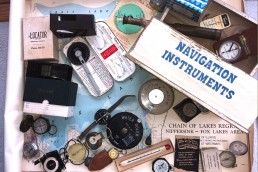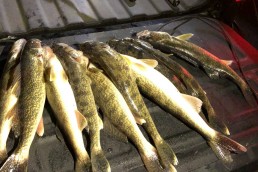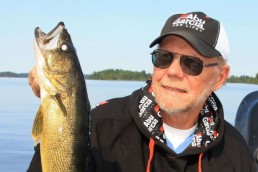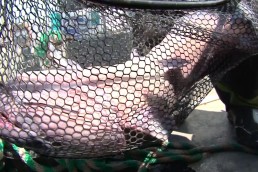Explore Early Fish Finding Equipment
SHARE THIS POST
Early fish finding gear gave the first peek beneath the waves
As we study the evolution of fishing, most focus is on the early lures, reels and rods. Meanwhile, the information about the early fish finding tools used to locate fish has been absent and under-appreciated. Over the 60 years I have collected early fishing items, we have also gathered early fish finding items, here and there, that have reached sufficient numbers to now share these interesting inventions. They reveal the ideas designed to help anglers find fish and provide income to their makers.
In presentations to various groups of anglers, we share these early artifacts, jokingly proclaiming, “I no longer fish tournaments as it wouldn’t be fair using these early fish finding instruments. No other competitor has these tools that locate and find the spots, measures depth, measures distances on maps, records barometric pressure, suggest productive lures and more. It would be like taking candy from babies. I just couldn’t live with myself taking advantage of other competitors with these very scarce tools that they don’t have a chance to own.”
Tools of a very old trade
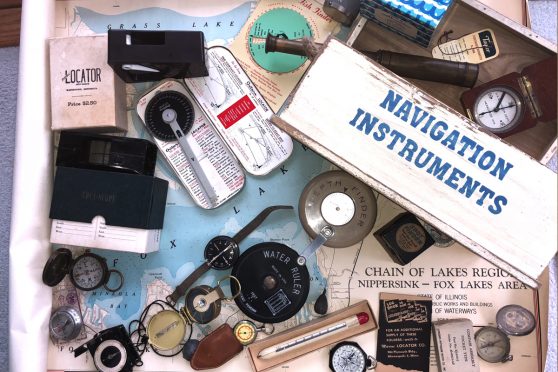
Laid out on a map from the State of Illinois in 1956 (back then it didn’t even show depths of the lake bottom or structure), an angler had to use tools like these, fish blindly or, more often, just cast to the bank. In addition, no one was teaching about structure. Anglers back then talked about good spots.
The three items in the top left corner of the accompanying photo are arranged clockwise. The first is a Loca-Scope, still in its original box, from National Sales, Inc., Minneapolis, Minn. Instructions state, “It was invented in answer to the oft-expressed desire of marking a location to which a sportsman desired to return. Loca-Scope exactly fills that need. It is not a toy. It is an optically perfect, precision-built sighting instrument of practical help to every sportsman. And you can’t wear it out.”
Angler’s peered through a window at two angled mirrors locating two landmarks, writing them on the pages provided while orienting the device north and south. Then, you would have to line up two other landmarks with the Loca-Scope oriented east and west to find the spot.
Patent-pending pieces of history
Next is the Thomas Locator, marked “Patent Applied For,” made in Watertown, Minn. Price was $2.50. With a lever pointing at numbers from 1 to 16 on top, user’s could focus on a landmark, then, with the lever, shift the view among landmarks recording two with their number, then return to that exact spot.
It comes with the most detailed instructions: “First when you’ve found a good spot, Anchor Boat! Returning To Spot, refer to your notes and go to the approximate area. Then, by using your locator you, can come within 10 feet of your original location.” Good luck, I expect that’s why the one I found is still like new.
Triangulation in a case
Next, Outers Locator entered the market for early fish finding gear with an aluminum device and case. Instructions state, “It’s so easy, locates your exact position, return to the same spot next day or next year. Fishermen go back where they found the big ones. Hunters find downed game, locate duck blinds, meet at an agreed place. Trappers find traps in deep snow. Campers locate camp. To locate a spot, point indicators at three easily identified objects and note for your exact location.”
Are you enjoying this post?
You can be among the first to get the latest info on where to go, what to use and how to use it!
Netcraft, founded in 1941 in Toledo, Ohio had a small, black, two-inch, boxed, divided mirror cube named Spot Finder with directions to, “Mark Your Favorite Spot!” It was, no doubt, the low-cost alternative.
The laminated card, 4-Site Fish Finder contains a rotating wheel with a window to point to water temperature. Its two windows reveal depth to fish and six species. The other window revealed the lures to use with letters whose code was on the lower part of the card. It was made by the 4-Site Company, 235 West Lake Street, Chicago, Ill., in 1948.
The beginnings of bottom studies
The Depth Finder by Brion Co. and Water Ruler marked “Made in USA Patent Pending” were reels with a weight on line and depths indicated on the device faces. Brion was featured in the September 1960 Popular Mechanics titled, “Mechanical Depth Finder for Fishermen. Smart fishermen study their geography underwater, because the one who knows the reefs, bars and deep holes, often has the best chance of catching fish. But, mapping the bottom of a lake or even finding the depth at one spot can be quite a job. A new mechanical depth finder does the job easily by releasing a weighted line and registering the amount paid out on a graduated dial. The release lever is also the retrieving crank. It’s available in 50-foot or 100-foot models.”
Go deeper in your search for big bass with our guide to drop-shotting for deep-water bass.
Navigating to the future
A major find was the well-made wooden box labeled Navigation Instruments. It contained a brass spyglass and wood-cased compass by Herschede 1918 with East and West on the wrong sides. We have seen several of this type, but don’t know why they were made this way. Do you?
Other compasses in this Navigation Instruments box vary greatly in quality. One is by Longines-Wittnauer Watch Company Inc. Others have sights the user could use navigating.
I wonder if, in six decades, anglers will view our present navigational fish-finding devices as primitive? Will they, then, see them as we view these early fish finding devices?
Author notes
Dan Basore is a fishing historian and steward of the history of the sport. In his efforts to preserve fishing history, Basore is always on the lookout for information about early lure makers, old lures, pre-level wind reels, manufacturers catalogs, tournament casting items and the like. If you possess information or materials that can help preserve and share fishing history please email ollures@aol.com or text 630-638-3474 or call 630-393-FISH (3474) or 800-FISH-LAKe (800-347-4525). Or write Dan Basore, 3S375 Herrick Road, Warrenville, IL 60555.
MWO
SHARE THIS POST
Did you enjoy this post?
You can be among the first to get the latest info on where to go, what to use and how to use it!
Dan Basore
Dan Basore is a fishing historian and steward of the history of the sport. In his efforts to preserve fishing history, he is always on the lookout for information about early lure makers, old lures, pre-level wind reels, manufacturer catalogs, tournament casting items and the like. If you possess information or materials of this kind, please contact him at 630-393-3474 or by email at ollures@aol.com.
